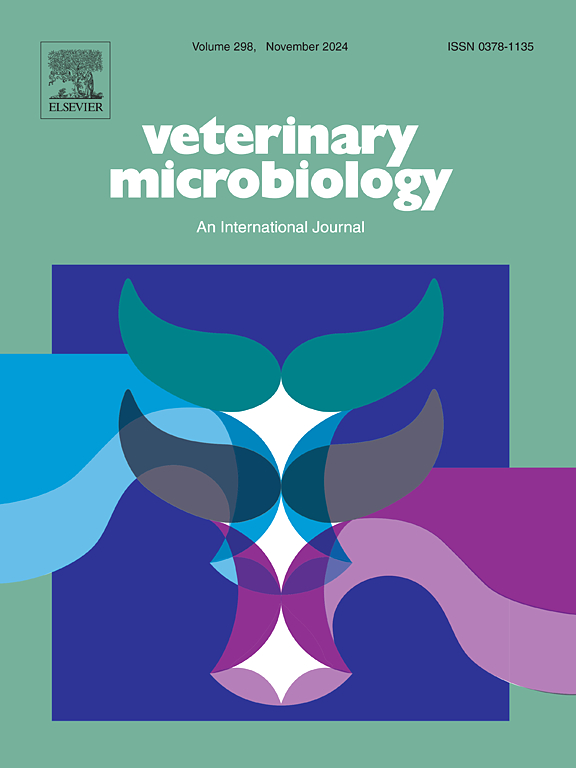An engineered canine-mouse chimeric neutralizing antibody provides therapeutic effects against canine parvovirus infection
IF 2.7
2区 农林科学
Q3 MICROBIOLOGY
引用次数: 0
Abstract
Canine parvovirus (CPV) is a highly contagious and severe infectious disease that can lead to hemorrhagic enteritis and even acute death in dogs. Despite mouse monoclonal antibodies (mAbs) have been employed in clinical treatment, their application in non-murine species is restricted due to immune rejection. In this study, we screened a mouse mAb (5E7) with high neutralizing activity against CPV using hybridoma technology. Subsequently, the variable regions of the heavy (VH) and light (VL) chains of 5E7 were amplified by PCR and fused with the constant regions of canine IgG antibody to produce canine-mouse chimeric antibody (CM-5E7). The chimeric antibody was successfully expressed in HEK293 cells and exhibited high neutralizing activity against multiple CPV subtypes in vitro. Furthermore, CM-5E7 exhibited effective therapeutic potential in dogs subjected to lethal dose CPV-2c challenge in vivo. Overall, CM-5E7 demonstrated high neutralizing activity against CPV and showed significant efficacy in treating CPV-2c infections, positioning it as a promising candidate therapeutic antibody for the treatment of CPV infection.
一种工程犬鼠嵌合中和抗体提供了治疗犬细小病毒感染的效果
犬细小病毒(Canine parvovirus, CPV)是一种高度传染性和严重的传染病,可导致狗的出血性肠炎甚至急性死亡。尽管小鼠单克隆抗体(mab)已用于临床治疗,但由于免疫排斥,其在非小鼠物种中的应用受到限制。在这项研究中,我们利用杂交瘤技术筛选了一株具有高中和CPV活性的小鼠单抗(5E7)。随后,通过PCR扩增5E7重链(VH)和轻链(VL)的可变区,与犬IgG抗体的恒定区融合,得到犬鼠嵌合抗体CM-5E7。嵌合抗体在HEK293细胞中成功表达,并在体外对多种CPV亚型表现出较高的中和活性。此外,CM-5E7对体内CPV-2c致死剂量攻击的狗显示出有效的治疗潜力。综上所述,CM-5E7对CPV具有较高的中和活性,对CPV-2c感染具有显著的治疗效果,是一种有前景的治疗性抗体。
本文章由计算机程序翻译,如有差异,请以英文原文为准。
求助全文
约1分钟内获得全文
求助全文
来源期刊

Veterinary microbiology
农林科学-兽医学
CiteScore
5.90
自引率
6.10%
发文量
221
审稿时长
52 days
期刊介绍:
Veterinary Microbiology is concerned with microbial (bacterial, fungal, viral) diseases of domesticated vertebrate animals (livestock, companion animals, fur-bearing animals, game, poultry, fish) that supply food, other useful products or companionship. In addition, Microbial diseases of wild animals living in captivity, or as members of the feral fauna will also be considered if the infections are of interest because of their interrelation with humans (zoonoses) and/or domestic animals. Studies of antimicrobial resistance are also included, provided that the results represent a substantial advance in knowledge. Authors are strongly encouraged to read - prior to submission - the Editorials (''Scope or cope'' and ''Scope or cope II'') published previously in the journal. The Editors reserve the right to suggest submission to another journal for those papers which they feel would be more appropriate for consideration by that journal.
Original research papers of high quality and novelty on aspects of control, host response, molecular biology, pathogenesis, prevention, and treatment of microbial diseases of animals are published. Papers dealing primarily with immunology, epidemiology, molecular biology and antiviral or microbial agents will only be considered if they demonstrate a clear impact on a disease. Papers focusing solely on diagnostic techniques (such as another PCR protocol or ELISA) will not be published - focus should be on a microorganism and not on a particular technique. Papers only reporting microbial sequences, transcriptomics data, or proteomics data will not be considered unless the results represent a substantial advance in knowledge.
Drug trial papers will be considered if they have general application or significance. Papers on the identification of microorganisms will also be considered, but detailed taxonomic studies do not fall within the scope of the journal. Case reports will not be published, unless they have general application or contain novel aspects. Papers of geographically limited interest, which repeat what had been established elsewhere will not be considered. The readership of the journal is global.
 求助内容:
求助内容: 应助结果提醒方式:
应助结果提醒方式:


